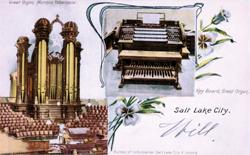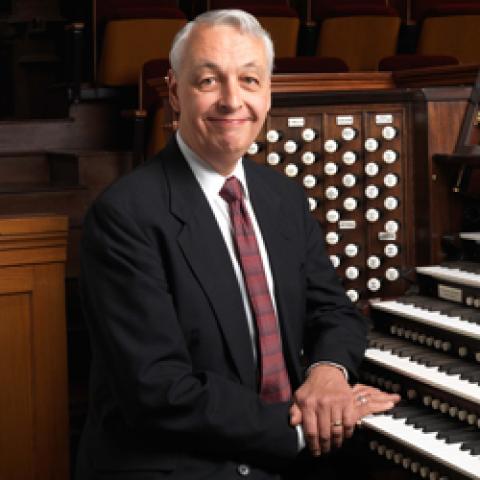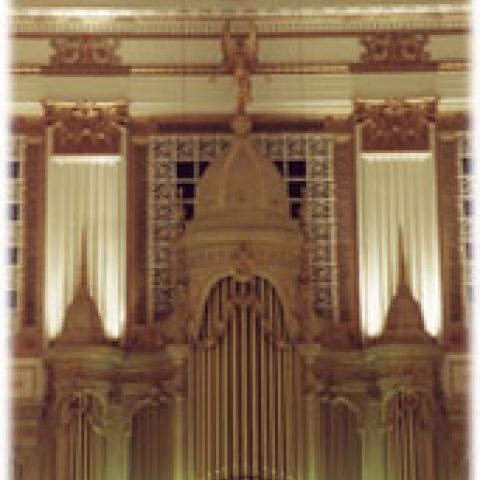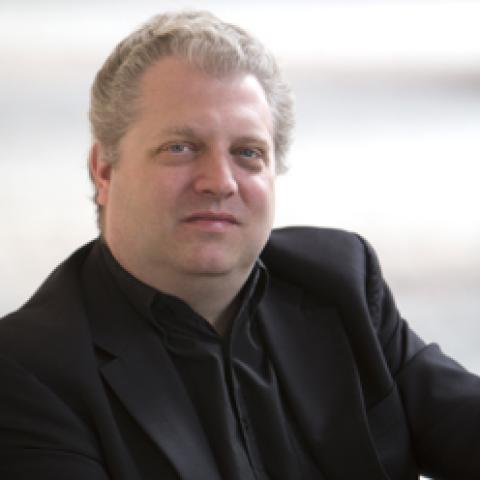The present pipe organ at St. James United Church is unique among Montréal’s many interesting organs because much of the organ’s pipework dates back to an 1889 instrument by E.D. Wadsworth & Brothers, Organ Builders. Edward Wadsworth opened his own organbuilding company in Manchester, England, in 1861 after apprenticing with Kirtland & Jardine; his family subsequently continued in the organbuilding trade under various forms of the Wadsworth name until 1946, when the company was absorbed by Jardine & Company of Manchester. Present-day British organbuilding colleagues have suggested that earlier Wadsworth organs with mechanical actions are superior to the later pneumatic examples, but it remains clear that the Wadsworth name never achieved the status of other British builders during the latter half of the 19th century, such as William Hill, “Father” Henry Willis, or T.C. Lewis.
Perhaps sensing new business opportunities, Edward Wadsworth moved to Montréal in 1887 to establish a branch office of the family company at 298 Craig Street (which today is called rue St-Antoine). The company built two instruments in Canada, the first being a small tracker organ of ten stops for Trivett Memorial Church in Exeter, Ontario, in 1888. The second project for St. James Methodist Church (as the church was originally known) was on a grander scale; the handwritten contract dated June of 1888 was for a grand pipe organ of 49 stops with “tractile” key action. The price for the new organ was established at $11,550, less $2,375 for the church’s old pipe organ. For reference, the signing of the Wadsworth contract took place at the same time as construction was ongoing in the workshops of Samuel and Claver Casavant of a 73-stop instrument for Montréal’s Basilique Notre-Dame; the price for the Casavant organ was some $24,800.
With a 32′ flue stop in the pedal division and two divisions on each of the three manuals, the Wadsworth organ was a novel and complex instrument. The two divisions per manual could be played separately, or coupled together by the touch of a thumb piston under each manual. In addition, each manual had its own drawknobs for appropriate pedal stops and a dedicated “pedalier” thumb piston to bring the selected registration into play as one moved from manual to manual. The middle manual controlled the Great and Back Great divisions, while the Solo—in its own swell box—was partnered on the lowest manual with the unenclosed Choir. The Swell and Echo divisions, playable from the third manual, were enclosed together.
A comparison of the 1888 contract to the instrument’s final specification shows that two optional stops—a 16′ Lieblich Gedackt for the Choir and a 16′ Contra Fagotto for the Solo—were added as the organ was being built. Stops were equally rearranged within the specification, presumably for a better musical result: The 16′ Contra Fagotto was moved to the Back Great division with the Great 8′ and 4′ reeds, permitting the reeds to be brought in or retired collectively in a ventil-like fashion via the thumb pistons under the Great manual. The 8′ Vox Humana likewise migrated from the Solo division to the Echo, while the 8′ Gamba and 8′ Voix Celeste stops came together in the Solo from their separated locations in the Swell and Echo divisions respectively.
Lynnwood Farnam served as organist for St. James Methodist Church from 1904 to 1905, and was well acquainted with the Wadsworth instrument. His notebook entry on the organ provides many details on the as-built stoplist and forms the basis for our understanding of the completed 1889–91 Wadsworth instrument. Though Farnham’s pages on the St. James organ are typically meticulous, it is unclear what kind of key action or key actions Wadsworth employed in his instrument; but it seems highly unlikely that the organ had purely mechanical key action. At the least, some form of pneumatic action would have been employed to manage the complexity of two divisions per manual. Farnam does list all couplers as operating pneumatically, with the console having the six usual unison couplers along with sub and octave couplers for the Swell manual, and a Swell to Great Sub coupler.
Unfortunately, the luster literally wore off the Wadsworth instrument at St. James Church within two years of its completion in 1889. The new organ was frequently crippled by problems arising from humidity and heating within the new church building. The church acknowledged this in an indenture document signed with Wadsworth in June 1891, wherein the complaint was also lodged that the organ’s “exterior has not preserved its absolutely fresh appearance.” The agreement offered Wadsworth an additional $1,000 to repair and otherwise complete his instrument, which, according to the document, had already been in place for two years.
The results of this remedial work were proclaimed satisfactory in a letter dated September 23, 1891, from the agreed-upon arbiter, Frederick Archer, to John Torrance, Secretary to the Trustees of St. James Methodist Church:
My dear Sir,
I have this day examined in detail the organ erected by Mr. E. Wadsworth in St. James Church, Montreal with the following results.
I find the wind supply is now ample for every possible purpose, its transmission to every junction of the instrument with uninterrupted “steadiness”. The wind trunks, sound boards, etc. are perfectly air tight and the whole of the mechanism is in thoroughly satisfactory condition.
The repairs have been carefully and substantially done in full accordance with the agreement entered into with him in June last, and with ordinary care and attention, the instrument will, to the best of my knowledge and belief, be now found entirely adequate to all legitimate demands made on it.
. . . I am pleased to be able to report so favourably, but as Mr. Wadsworth has evidently done his work of renovation in so conscientious and thorough a manner, it is but one to him that I could bear witness of the fact.
Archer was a renowned English organist and choral conductor living in the United States, with a reputation as an expert on pipe organs that extended as far as Montréal; he played three dedicatory concerts on the Casavant organ at la Basilique Notre-Dame in May of 1891.
If the Wadsworth instrument was indeed playing as early as 1889, this raises questions about how such a large pipe organ was built within a year by an organ builder who had only arrived in Montréal a few years earlier. For example, from where did Wadsworth obtain his pipework for the new St. James organ? One distinct possibility is that he purchased pipes from another builder such as S.R. Warren & Sons or from a supply house. Similarly, Wadsworth may have ordered pipes from the family workshops in Manchester, England, and had them shipped to Canada. Having said that, Wadsworth was accused of using old pipework in the new organ for St. James Church, including the Pedal 16′ Trombone and the Echo 8′ Hautbois. Our survey of the organ’s present pipework suggests that some ranks pre-date 1889: the f#19 pipe of the Great 16′ Double Diapason, for example, is clearly scribed “1881”, some seven years before the organ’s contract was signed.
Considering the spatial volume of the sanctuary at St. James’ Church and the organ’s recessed location within the chancel, the scaling of the Wadsworth pipework is surprisingly modest in comparison with the large organs of, say, William Hill. The original Great 8′ Open Diapason approaches the Normalmensur (NM) standard around 4′ C and again in the 1′ octave but never exceeds it. The Great 4′ Principal is consistently two to three pipes smaller than the 8′, and it is only in their uppermost octaves that the Great 22⁄3′ Twelfth (a tapered rank) and 2′ Fifteenth ranks exceed NM. These statements are slightly complicated by Warren’s re-scaling and re-pitching of the original pipework in their later reconstruction, but it remains that the scalings of Wadsworth’s principals and choruses were unexpectedly reticent. The quality of the Wadsworth pipes is unremarkable when compared with the later Warren and Casavant pipes, and while most of Wadsworth’s metal pipes were made from spotted metal, the metal itself is quite thin. The Swell 8′ Viola Ætheria is an extreme example: the spotted metal in the bass octaves is so thin that lifting the pipe carelessly from the top can easily deform the pipe’s body. The effect produced by these moderately scaled pipes sounding on generous wind pressures and having been voiced to fill a large room is one of surprising brilliance and great clarity.
Wadsworth’s wooden stops throughout the organ were unvarying, with stopped bass and tenor octaves that transition to open pipes with inverted mouths at c25, similar to a Melodia. The Solo 8′ Concert Flute and the Choir 8′ Lieblich Flute are traditional in the sense that the open pipe bodies are deeper than they are wide, but the proportions for the Great 8′ and 4′ flutes are notably wide and shallow. The present Choir 8′ Flute Celeste originally served as Wadsworth’s 8′ Echo Flute and also features this type of wide mouth construction. Like the metal pipes, the quality of construction is adequate but unexceptional; the thickness of the wood is consistently thinner than the later Warren pipes, and the quality of the joinery is slightly coarse and uneven.
Though E.D. Wadsworth & Bros. was still advertising in the Montréal area as late as 1902, it is unclear what happened to Edward Wadsworth after the completion of the St. James organ in 1891. Wadsworth did not achieve fame or fortune with the St. James’ organ: within days of Frederick Archer’s note pronouncing the organ complete in September 1891, Wadsworth sent the church trustees a handwritten note requesting an advance of $30 as he found himself “rather short.”
The Wadsworth organ served the church for eighteen years, a period that included Lynnwood Farnam’s tenure as organist. It was replaced in 1909 with a pipe organ by the Warren Church Organ Company, reusing a majority of the Wadsworth pipes, at a cost of $6,000. The Warren Church Organ Company was established in Woodstock, Ontario, in 1907 by Frank, Mansfield, and Russell Warren, and can be considered the last vestige of the once-proud Warren name in Canadian organbuilding.
The Warren organ added a number of new stops and redistributed most of the Wadsworth ranks throughout the instrument. A massively scaled 8′ Open Diapason was added to the Great, displacing Wadsworth’s original to secondary status. The Choir division was enhanced by a new 8′ Cor anglais with free reeds; this stop was likely purchased from a supplier, as its construction details are unlike anything else in the organ. A new Solo division was also provided on some 10′′ of wind and included new Stentorphone, Doppelflöte, German Gamba, and Tuba stops.
It appears Warren provided all-new wind chests rather than reusing the Wadsworth chests; this conclusion is based on Farnam’s description of the operation of the sub octave (G) and octave (A) couplers for the Great division and the general increase in the number of stops per division. The rearranging of the Choir to reside within the same expressive enclosure as the Swell, and likewise the Echo with the Solo, is further confirmation that the 1909 instrument represented substantial change behind the original Wadsworth façade.
The new Warren console of four manuals provided a new level of flexibility for organists, with each piston being adjustable by drawing the desired stop combination and then pulling the piston head out by a fraction of an inch. There were a total of four pistons operating on the entire organ and between three and five pistons operating on each division. The console also featured a pédale à bascule (a balanced pedal) providing a general crescendo and diminuendo effect.
Our examination of the pipework suggests that the pitch of the Wadsworth pipes was sharp of modern concert pitch (A=440Hz). To lower the pitch, Warren moved all of the Wadsworth stops up by one note and provided a new low C pipe for each stop; this served to increase the scale of each stop by one pipe in the process. The Warren company also filled out the gaps in Wadsworth’s numerous short-compass stops, such as the Great 16′ Contra Fagotto, Choir 8′ Clarionet, Echo 8′ Echo Flute, Choir 8′ Dulciana, and the Choir 8′ Voix Celeste.
Warren went beyond re-pitching the organ in some cases and rescaled several ranks, likely to achieve a fuller sound. It is equally possible that Wadsworth himself may have engaged in some re-scaling to suit his purposes, if one allows he recycled older pipework in his 1889 instrument. For instance, the Choir 4′ Flûte Octaviante and Great 4′ Principal ranks both have many pipes marked with three successive pitches, suggesting that the original scale was too small. In the same way, the Swell 8′ Open Diapason and 4′ Octave stops have been rescaled no less than three times by their fourth octave. As with adjusting the scales of various stops, there is no reason to think Warren would have hesitated to increase wind pressures and/or revoice the Wadsworth pipework as needed.
The Warren company was equally revisionist with the organ’s reed stops. The scales for Wadsworth’s original Great reed chorus were surprisingly thin—notably smaller than the Swell chorus—so Warren replaced the Great 8′ Trumpet with a new stop of larger scale. The original 8′ Trumpet was reworked into a 16′ Bassoon for the Swell division, with Warren providing twelve new half-length pipes for the bottom octave. Warren also added eighteen new full-length pipes to complete the missing bass of the Great 16′ Contra Fagotto. In fact, the only Wadsworth reed stops to emerge from the Warren workshops relatively untouched—beyond being shifted up one pipe as part of re-pitching the organ—were the Swell 8′ Cornopean, the Great and Swell 4′ Clarions and possibly the Swell 8′ Vox Humana (which disappeared in 1956). Most of Wadsworth’s color stops were replaced outright, though the 8′ Clarionet was rebuilt with new shallots, blocks, and boots, as well as equipped with new adjustable bells for tonal regulation. The 1889 organ had two oboe stops—the Solo 8′ Orchestral Oboe and the Echo 8′ Hautbois—though Farnam’s notes state that the Orchestral Oboe’s pipes had been “taken out” by the time of his visit. Neither stop survived; the pipes for both the present Swell 8′ Oboe and the Solo 8′ Orchestral Oboe are consistent in terms of construction and materials with Warren’s other work.
Farnam returned to St. James Methodist Church on February 15, 1910, to play the new Warren organ, and his notes again provide useful details about the changes that were wrought. Farnam did not seem entirely pleased with all of the changes made to the instrument, noting that the “32-foot has been quite ruined…” and all of the 2′ stops seemed very “spiky,” especially the 2′ Fifteenth in the Great. He praised the new electric key action, though went on to mention the Swell action was very noisy from inside the instrument.
After nearly thirty years of service from the Warren organ, St. James United Church—note the change in name—signed a contract with Casavant Frères in July 1938 for an organ that reused almost all of the old pipework on new windchests. As stipulated in the purchase agreement, the organ would be installed by December 18, 1938—some five months later—at a cost of $16,000. Wadsworth’s 16′ façade was to be preserved, though Casavant successfully lobbied to have the façade moved two feet towards the nave to accommodate the enlarged instrument. The short amount of time between the contract signing and the project’s anticipated completion may reflect the lingering effects of the Great Depression; it is likewise indicative that Casavant agreed to finance nearly half of the contract amount over a three-year period after the organ had been completed!
Casavant’s Opus 1608 incorporated their state-of-the-art electro-pneumatic windchests with pitman-type stop actions built into the pouchboards for instantaneous registration changes. The compasses of the manual divisions were increased from 61 notes to 68 notes, and the number of pedals increased from 30 to 32 notes. The organ’s wind system was comprehensively redesigned, reusing old wind reservoirs and their cone-valve regulators where practical. A new four-manual console was also provided, incorporating Casavant’s pneumatic combination action and trademark furnishings. Like Warren, Casavant consolidated the instrument’s specification from five manual divisions to four—eliminating the Echo division—and transferred several stops between divisions in the process. The Swell, Choir, and Solo divisions were furnished with independent expressive enclosures, each operated by Casavant’s 8-stage pneumatic motors.
A new Nazard 22⁄3′ made up of stopped pipes was added to the Choir, while a 4′ Violina—made up largely from repurposed pipework—was added to the Solo division. The Pedal division was augmented through new extensions to the existing stops, though the Wadsworth 16′–8′ Violone rank appears to have been entirely replaced in 1938 with new pipes. The original Pedal 16′ Trombone with its wooden shallots was extended downward by twelve full-length pipes to create the 32′ Bombarde stop, with the entire rank sounding on 7′′ wind pressure. The Carillon (or Chimes) tubes were maintained from the 1909 instrument but provided with a new striker rail, and a new 61-note Harp was added. Finally, whatever was left of Wadsworth’s “ruined” 32′ Open Diapason was eliminated, and a new 32′ Acoustic Bass stop was provided with twelve independent pipes sounding at the fifth to create the 32′ effect.
The Wadsworth-Warren instrument would have been a comfortable fit with the tonal inclinations of Stephen Stoot, Casavant’s technical director in 1938. An Englishman, many of Stoot’s instruments drew from this heritage, and in this sense the Wadsworth and Warren materials would not have seemed particularly foreign—though there may have been some disappointment with their quality. As one example, the placement of reed choruses on separate windchests was a trend in English organbuilding during the late Victorian and Edwardian eras, enabling higher wind pressures for the reed stops for a smoother tone. At St. James, the Great and Swell reed choruses were indeed separated in this manner, but the similar wind pressures between flues and reeds ultimately made this something of a hollow gesture.
After 1938, the organ saw a few changes prior to the restoration undertaken in 2011–12. The 8′ Vox Humana in the Swell division was replaced during the mid-1950s with a stopped 22⁄3′ Nazard rank. In the 1980s, the original Great mixtures were replaced with two new stops that were poorly suited to the instrument’s aesthetic. Likewise, the Great and Swell reed choruses were modified to give a brighter tone, with the resonators being cut to length after the original regulating slots had been soldered shut. One other significant change relates to the instrument’s appearance: church photos show a heavy drape hung above and to the sides of the Wadsworth façade, serving to hide the windchests and pipes from the Great and Pedal divisions. This drape was in place until possibly the early 1980s but it is unclear when exactly it disappeared; Philip Crozier, Director of Music at St. James, relates the drape had been removed by the time he was hired in 1986. The drape’s disappearance would have surely had some effect on the sound of the organ, tilting the organ’s tonal balance towards an even more present and brilliant sound—though to what degree can only be guessed.
The restoration work undertaken by Orgues Létourneau Limitée over a twelve-month period included re-leathering all of the electro-pneumatic windchest actions; restoring all of the wind reservoirs and other wind system components; and documenting in detail the instrument’s pipework. Forty ranks from the original Wadsworth instrument have survived, though many ranks have been subsequently rescaled or rearranged as described above.
As part of the restoration effort, two new mixtures were built for the Great division to replace the unsuitable examples added in the 1980s. In the absence of information regarding their original compositions, the new mixtures’ breaks follow English examples contemporary to the Wadsworth instrument, while the scalings follow progressions established by the Great 2′ Fifteenth and the original Swell mixture. The mild Swell mixture (containing a tierce rank) was restored to its original specification, with the two breaks returning to their original places at c25 and f#31. Finally, a new slotted 8′ Vox Humana in the style of Father Willis was developed and installed in the Swell division.
After nearly 75 years of service, the four-manual console was thoroughly rebuilt to discreetly incorporate modern playing conveniences, including multiple memory levels, additional thumb pistons, and a general piston sequencer. The organ’s switching system and wiring—much of it dating back to 1938—was entirely replaced with a new state-of-the-art system. Beyond the Wadsworth pipework from 1889, some of the instrument’s more intriguing tonal features include the full-length 32′ Bombarde, the Solo 8′ Stentorphone with its leathered upper lips, the free-reed 8′ Cor Anglais, and the 61-note Harp stop in the Choir division.
The organ was tonally regulated within the church by a team of Létourneau voicers over the course of several weeks in early 2012. Shortly thereafter, the church’s offices and meeting spaces were heavily damaged in a fire, though the sanctuary and the organ were spared. The restored organ was first heard in concert during the church’s annual noon-hour series throughout the following summer, and as autumn approached, the organ served as the “home” instrument for the annual Orgues et Couleurs festival, with two major solo concerts performed by Johann Vexo and Philip Crozier. Since Mr. Crozier’s appointment as Director of Music, the organ has been heard in a continuous series of summer recitals over the past 26 years, with the single exception being the summer of 2011, when the instrument was being restored in the Létourneau workshops.
An instrument in the English Town Hall tradition, the pipe organ at St. James United Church has played an important role in Montréal’s organ scene and has hosted concerts by renowned organists such as Lynnwood Farnam, Fernando Germani, Raymond Daveluy, André Marchal, Bernard Lagacé, E. Power Biggs, Francis Jackson, and Simon Preston. More recently, the instrument has been heard in performances by Joseph Nolan and Sietze de Vries. All of us at Létourneau Pipe Organs remain honored to have been entrusted with this significant restoration project and are pleased to see this pipe organ reclaiming its rightful place as one of Montréal’s most noteworthy instruments.
The author would like to thank the following individuals for their assistance in preparing this article: John Mander, Mark Venning, David Wood, Karl Raudsepp, Bill Vineer (The Vineer Organ Library), Allen Fuller, Philip Crozier, Fernand Létourneau, and Dany Nault.





